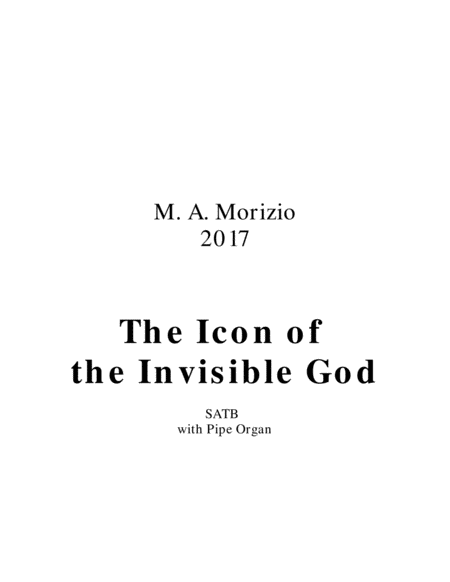Choral Choir (SATB) - Level 3 - Digital Download SKU: A0.926661 Composed by Michael A. Morizio. Christian,Sacred. Octavo. 15 pages. M.A. Morizio #3588399. Published by M.A. Morizio (A0.926661). In the first chapter of Paulâs letter to the Colossians, we discover the next known Hymn to Christ right after his introductory passages, beginning at the 15th verse. Paul opens this letter with a blessing, then immediately flows to one of the 1st century hymns, which I have called, The Icon of the Invisible God. The lyrics of this hymn are declarative, bold and illuminating as to whom the Christ figure is-the icon, the very image of the invisible God, the firstborn of all creation. The text makes it abundantly clear that Jesus is the authority; that He was there before all things, that He created all things, and that through Him all things hold together. This anthem is composed for SATB choir with Pipe Organ accompaniment. The meter is set to 6/8 time, with a rhythm tempo of Totally Alive; which is one actual definition of the word Holy. The anthem starts at a good clip (âª=100). The key is G Major, with an incidental and occasional flatted 5th (Dâ) as a surprise-landing befitting to the text presented, as if to say, This is so amazing, how can it be? The flatted 5th gives the piece it's own identity and causes the listener to stand up and take notice whenever it occurs. When the hymn's lyrics glide into the all-important resolution, having made peace through the blood of the cross, the song retards and lands on a surprising musical cadence, the sixth chord (E Major). In this piece, the pipe organ is boldly featured as it supports and under girds the musical line, occasionally trumpeting its own victorious motifs and adding some contrapuntal elements, such as this duplet motif, in the pedal line. The final lyrics about Christ having reconciled everything to Himself, whether things on the earth or in the heavens, finish the piece with a great, âHigh-Churchâ choral ending.
